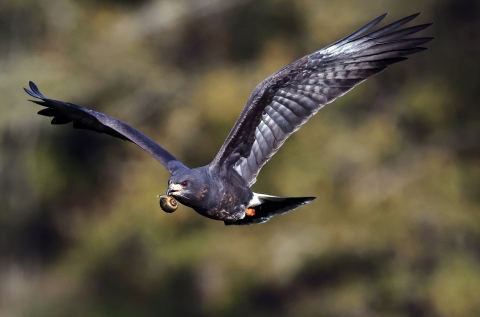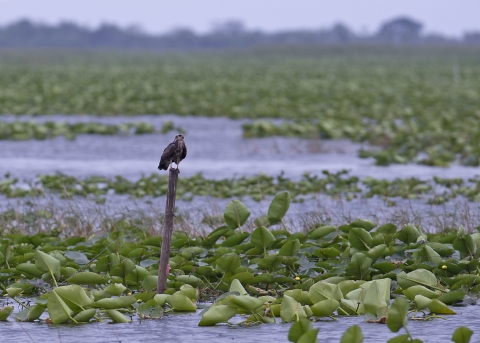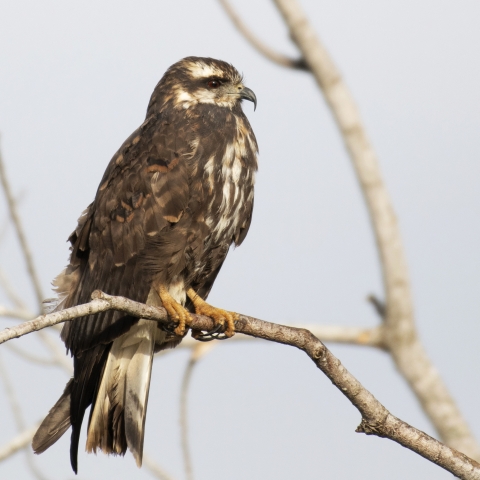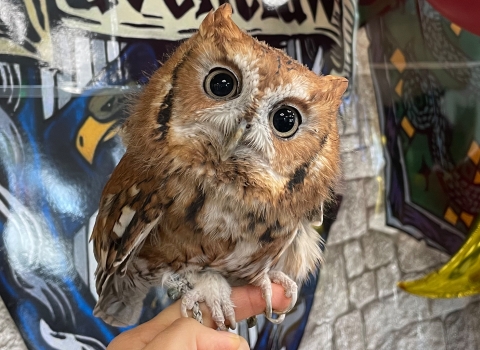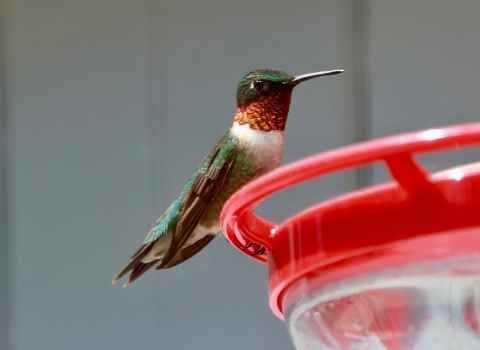The Everglade snail kite is a marvel of adaptation and a symbol of Florida’s wetland ecosystems. Protecting this unique bird means preserving the intricate balance of life that thrives in these watery landscapes.
If you’re visiting the wetlands of Florida, be sure to bring your binoculars and camera—you just might spot this fascinating raptor in action!
Identifying Features
- Size: Medium-sized hawk with a wingspan of about 45 inches, very similar to the marsh hawk but without the wavering, tilting flight.
- Coloration: The adult males are slate gray with black head and wing tips, a white patch at the base of a square tail, and red legs. The female has a buffy body, heavily streaked with dark lines, a white line above the eye, a white tail patch, yellow legs, and red eyes. The immature birds resemble the females, only they are darker and their eyes are brown.
- Wings: Their long, broad wings are built for gliding over wetlands, often giving the bird a graceful and slow appearance in flight.
- Hooked Beak: One of the most defining features of the snail kite is its strongly hooked beak, specifically adapted for eating its primary prey—the apple snail.
Where to Find Snail Kites: National Wildlife Refuges
Everglade snail kites are a rare sight in the U.S., where their range is limited to Florida. Their habitat is closely tied to wetlands, specifically those with freshwater marshes and lakes. If you're planning a trip to Florida to catch a glimpse of one, these National Wildlife Refuges offer some of the best opportunities:
- Arthur R. Marshall Loxahatchee National Wildlife Refuge: Located in the northern Everglades, this refuge is a haven for snail kites. Its expansive marshes are home to a rich population of apple snails, making it a top location for spotting these birds.
- Everglades Headwaters National Wildlife Refuge and Conservation Area: Everglades Headwaters National Wildlife Refuge lies in an area that is one of the great grassland and savanna landscapes of eastern North America. Still largely rural, this Greater Everglades area is a mosaic of seasonally wet grasslands, longleaf pine savannas, and cattle ranches that sustains one of the most important assemblages of imperiled vertebrate wildlife in the southeast U.S. and a large portion of the unprotected natural habitat remaining in peninsular Florida.
- St. Johns National Wildlife Refuge: While this refuge is closed to the public to protect sensitive bird nesting habitat, snail kites have been spotted in the area!
Keep in mind that snail kites are dependent on wetlands with healthy populations of apple snails, so their presence in certain locations may fluctuate with the conditions of their habitat.
What Makes Snail Kites Special?
Unlike many raptors that hunt a variety of prey, the snail kite is highly specialized and feeds almost exclusively on apple snails. Its sharp, curved beak is adapted to extract snails from their shells—something most other birds struggle to do.
This diet specialization also makes them particularly vulnerable to changes in their environment. Habitat loss, changes in hydrologic management, and invasive species invasive species
An invasive species is any plant or animal that has spread or been introduced into a new area where they are, or could, cause harm to the environment, economy, or human, animal, or plant health. Their unwelcome presence can destroy ecosystems and cost millions of dollars.
Learn more about invasive species can disrupt apple snail populations, putting snail kites at risk. In fact, they are listed as federally endangered in the United States due to habitat loss and changes in water management.
Despite these challenges, the Everglade snail kite is a resilient bird. Conservation efforts are ongoing to protect their wetlands, and their ability to travel long distances in search of food allows them to find new habitats when old ones become unsuitable.
Everglade Snail Kite Photo Contest
As part of our Bird of the Month series, we invite you to submit your photos of snail kites in a photo contest.
**In the file name of your photo, please include your first and last name, contact email address, and the location where the photo was taken. If these components are missing, we will have no way of contacting you if you win.**
Submissions will be judged by a panel of U.S. Fish and Wildlife Service employees. Once a winner is selected, they will be contacted via email and asked to sign a photo release form. This form protects the photographer's rights, ensures proper credits are given, and grants the U.S. Fish and Wildlife Service permission to share the photo on our social media channels. Please monitor your junk/spam folders towards the end of the month in the event that we reach out and our email lands there.
The winner will be announced publicly near the end of each month on our Southeast Regional Facebook and X (formerly known as Twitter) platforms.
A photo contest will occur each month for each featured bird species. At the end of 2024, all twelve winning photographs will be shared on our regional social media accounts.
Submit your original photos of snail kites here!
Fun Facts About Everglade Snail Kites
- Keen Hunters: Though they glide gracefully above wetlands, snail kites have an impressive ability to spot and capture snails even when they are partially submerged in the water. They can pluck snails right off aquatic plants with precision, making them specialized and highly skilled hunters.
- Keep your distance! Snail kites are vulnerable to harassment from humans – fleeing their nest if approached and leaving their offspring exposed. The U.S. Fish and Wildlife Service recommends staying at least 500 feet from any active snail kite nest, which are marked with warning signs in areas where human disturbance is likely.
- Sentinels of Wetland Health: Everglade snail kites are often considered an indicator species—their population health reflects the overall condition of Florida’s wetland ecosystems. If the wetlands thrive, so do the snail kites, but when water management or pollution harms these habitats, the kites are often the first to show signs of distress.
- Nesting Challenges: Snail kites build their nests in shrubs, trees, or low vegetation above water in marshlands. However, fluctuating water levels in Florida’s wetlands can affect nesting success. If water levels drop too low, the nests become accessible to predators like raccoons, threatening their young. Conversely, rapidly rising water levels can flood/destabilize nests, causing failure.


